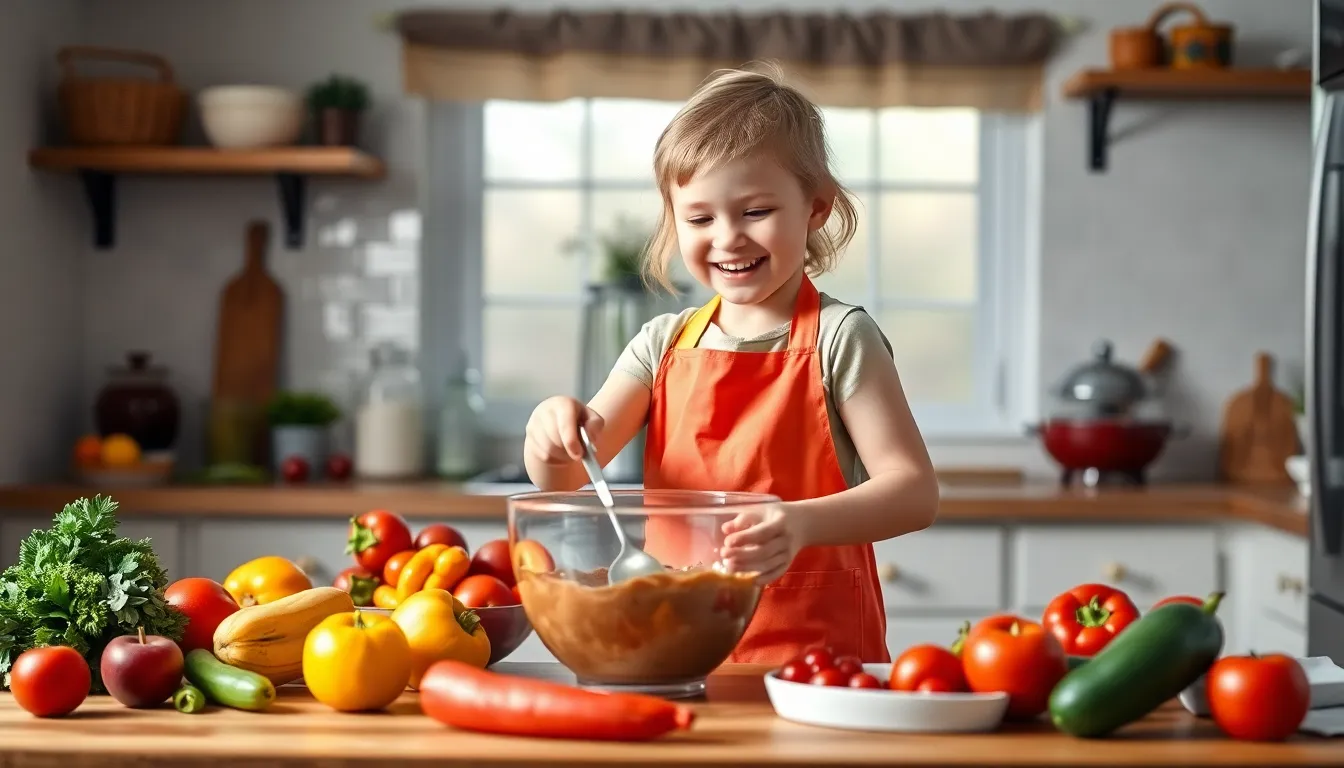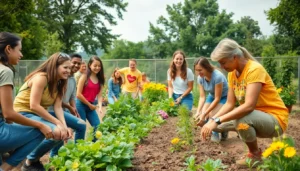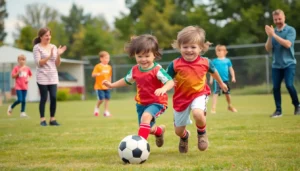Table of Contents
ToggleCooking with kids can be a delightful adventure that transforms the kitchen into a playground of flavors and creativity. Imagine the joy on their faces as they mix, stir, and taste their way through fun recipes. Not only does it keep them entertained, but it also sneaks in valuable lessons about nutrition and teamwork. Who knew that making a mess could be so educational?
Creative Childrens Cooking Ideas
Cooking fosters creativity and critical thinking. Here are some engaging ways kids can explore their culinary skills.
Easy Recipes for Beginners
Pancakes serve as an excellent starting point for young chefs. Mix flour, milk, eggs, and a pinch of salt for a basic batter. Let kids practice pouring and flipping, which helps build confidence. Fruit kabobs offer another simple option. Children can choose their favorite fruits, thread them onto skewers, and create colorful combinations themselves. Sandwiches also provide an easy path. They can layer ingredients per their preference, learning food assembly while getting imaginative.
Fun Cooking Activities
Building a pizza allows kids to exercise choice and creativity. Each child can add their favorite toppings, transitioning decisions into delicious results. Smoothie-making introduces them to blending. They can select fruits, yogurt, or juice, experimenting with flavors and textures. For another engaging option, organize a cookie-decorating session. After baking, children can unleash creativity and add frosting, sprinkles, or nuts. Baking bread also presents a memorable experience. Kids can knead dough and watch it rise, making the process fun and educational.
Healthy Eating through Cooking

Cooking offers a platform for children to learn about healthy eating while having fun. Engaging in the kitchen allows kids to explore foods, develop preferences, and understand nutrition firsthand.
Nutritional Benefits for Kids
Incorporating cooking into children’s routines enhances their understanding of nutrition. Kids learn to identify fruits, vegetables, and whole grains as essential components of a balanced diet. Exposure to various ingredients encourages healthy choices. Cooking together allows children to see how meals are prepared. They gain awareness of portion sizes and nutritional values. Research shows that children who cook are more likely to try new foods and make healthier choices.
Involving Kids in Meal Prep
Involving children in meal prep strengthens their culinary skills and promotes teamwork. Assigning age-appropriate tasks empowers kids and builds confidence. Younger children can wash vegetables or mix ingredients, while older kids can handle more complex tasks like chopping or sautéing. Making meal prep a family activity fosters communication and cooperation. Engaging kids in planning meals can also teach them about nutrition and balance. They can create grocery lists, choose recipes, and take ownership of their meals.
Seasonal Cooking Ideas
Cooking can vary with the seasons, offering delicious and fresh options throughout the year. Kids benefit from seasonal recipes, exploring flavors and ingredients as they cook.
Spring and Summer Recipes
Fresh fruits and vegetables abound during spring and summer. Kids can prepare colorful salads using lettuce, tomatoes, and cucumbers. Creating fruit smoothies with strawberries, bananas, and yogurt makes for a refreshing treat. Exploring recipes for homemade popsicles using fruit juice and diced fruits encourages creativity. Encouraging children to garden adds an educational element, teaching them where food comes from. Incorporating seasonal herbs like basil and mint into dishes elevates flavors and provides new culinary experiences.
Fall and Winter Delights
Fall and winter bring heartier recipes ideal for family gatherings. Kids can help make pumpkin soup using pureed pumpkin, onions, and spices. Baking apple crisp with sliced apples and oat topping showcases seasonal fruits. Crafting gingerbread cookies during the holidays engages creativity through decorating and shaping. Nutrient-rich root vegetables, such as carrots and sweet potatoes, can be roasted together for a comforting dish. Preparing warm beverages like hot cocoa or spiced cider introduces kids to seasonal traditions.
Cooking Safety Tips for Kids
Cooking safety forms a crucial part of the culinary experience for kids. Supervision from an adult reduces risks significantly. Kids should wash their hands to prevent contamination. Engaging them in this simple practice reinforces hygiene awareness.
Using age-appropriate tools helps ensure safety. Short knives, for example, can aid in teaching cutting skills without posing significant risk. Additionally, children should learn how to handle hot items carefully. Kitchen mitts make it easier for kids to manage hot pans or trays.
Teaching children about fire safety proves essential as well. They must understand the dangers of open flames and learn how to operate appliances like the stove responsibly. Establishing clear boundaries in the kitchen reduces incidents.
Encouraging a clean workspace goes further than aesthetics. Clutter can lead to accidents, so kids should be taught to keep their work areas tidy. Emphasizing the importance of cleaning spills immediately keeps the kitchen safe and organized.
Discussing the importance of adult assistance also emphasizes safety. Some tasks, like using sharp kitchen equipment, require adult supervision to ensure the child’s well-being. Demonstrating the correct way to use kitchen gadgets fosters a safer learning environment.
Finally, engaging in discussions about food allergies proves vital. Educating kids on common allergens promotes awareness and encourages safe cooking practices. Children should know how to identify potentially harmful ingredients in their recipes.
By focusing on these safety tips, kids gain confidence and develop essential skills while enjoying their time in the kitchen.
Cooking with kids opens up a world of fun and learning that extends beyond the kitchen. It nurtures creativity and critical thinking while instilling valuable life skills. By exploring seasonal recipes and engaging in hands-on activities, children not only develop their culinary abilities but also gain a deeper understanding of nutrition and healthy eating habits.
Involving kids in meal prep fosters teamwork and communication, creating lasting family memories. Prioritizing safety ensures a positive cooking experience, empowering children to take on age-appropriate tasks with confidence. Embracing cooking as a regular activity can lead to healthier choices and a lifelong appreciation for food.






